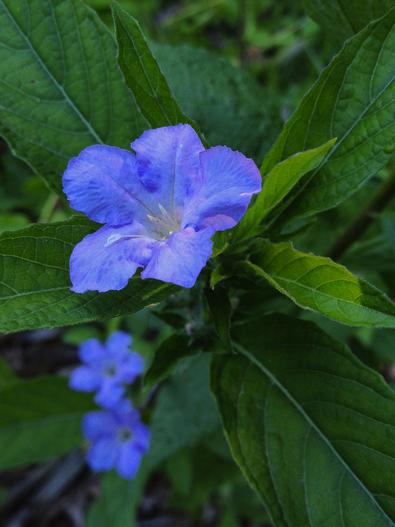Carolina Wild Petunia
(Ruellia carolinensis)
Carolina Wild Petunia (Ruellia carolinensis)
/
/

Fritz Flohr Reynolds
CC BY-SA 2.0
Image By:
Fritz Flohr Reynolds
Recorded By:
Copyright:
CC BY-SA 2.0
Copyright Notice:
Photo by: Fritz Flohr Reynolds | License Type: CC BY-SA 2.0 | License URL: https://creativecommons.org/licenses/by-sa/2.0/ | Uploader: FritzFlohrReynolds | Publisher: Flickr

Estimated Native Range
Summary
Ruellia carolinensis, commonly known as Carolina Wild Petunia or Carolina Ruellia, is a perennial herb native to the Southeastern United States. It is typically found in a variety of habitats including moist to dry woodlands, forest margins, stream banks, and fields, as well as in open disturbed areas. This species grows at a moderate rate to a height of 1-2.5 feet (0.3-0.8 meters) and a width of 1-1.5 feet (0.3-0.5 meters). It features lance-shaped leaves and produces purple or lavender flowers that are quite showy and bloom in the summer months. The flowers attract pollinators such as butterflies and bees, adding to the ecological value of the plant.
Carolina Wild Petunia is appreciated for its ease of maintenance and the splash of color it provides when in bloom. It is commonly used in native plant gardens, borders, and as a ground cover. This plant is adaptable to a range of soil types, including clay, loam, and sandy soils, as long as they have medium drainage. It thrives in full sun to part shade and requires medium amounts of water, making it a versatile choice for gardeners. While generally pest-free, it can be susceptible to root rot in overly wet conditions. Carolina Wild Petunia can self-seed prolifically, which is a consideration for gardeners who wish to prevent it from spreading too freely.CC BY-SA 4.0
Carolina Wild Petunia is appreciated for its ease of maintenance and the splash of color it provides when in bloom. It is commonly used in native plant gardens, borders, and as a ground cover. This plant is adaptable to a range of soil types, including clay, loam, and sandy soils, as long as they have medium drainage. It thrives in full sun to part shade and requires medium amounts of water, making it a versatile choice for gardeners. While generally pest-free, it can be susceptible to root rot in overly wet conditions. Carolina Wild Petunia can self-seed prolifically, which is a consideration for gardeners who wish to prevent it from spreading too freely.CC BY-SA 4.0
Plant Description
- Plant Type: Herb
- Height: 1-2.5 feet
- Width: 1-1.5 feet
- Growth Rate: Moderate
- Flower Color: Purple, Purple
- Flowering Season: Summer
- Leaf Retention: Deciduous
Growth Requirements
- Sun: Full Sun, Part Shade
- Water: Medium
- Drainage: Medium
Common Uses
Bird Garden, Border Plant, Butterfly Garden, Deer Resistant, Drought Tolerant, Groundcover, Low Maintenance, Rabbit Resistant, Street Planting
Natural Habitat
Moist to dry woodlands, forest margins, stream banks, fields, and open disturbed areas
Other Names
Common Names: Carolina Ruellia
Scientific Names: , Ruellia carolinensis, Dipteracanthus ciliosus var. dentatus, Dipteracanthus mitchellianus, Pattersonia carolinensis, Ruellia carolinensis var. cheloniformis, Ruellia carolinensis var. dentata, Ruellia carolinensis var. membranacea, Ruellia carolinensis var. nanella, Ruellia carolinensis var. parviflora
GBIF Accepted Name: